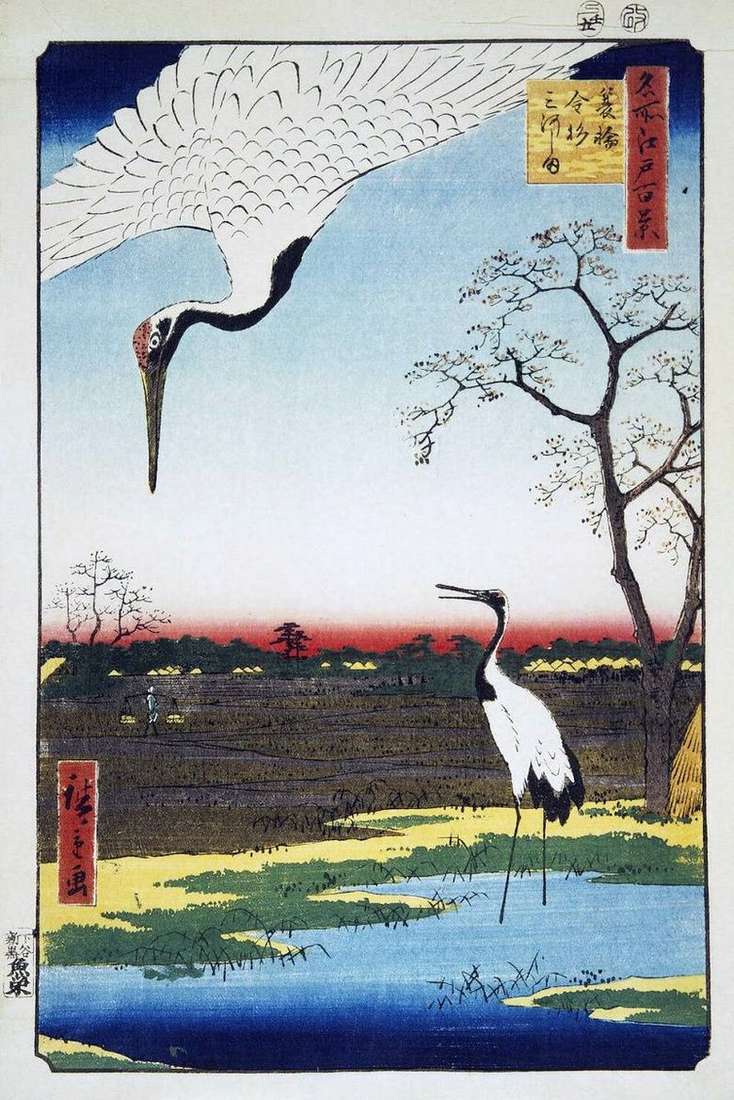
The series “One hundred famous kinds of Edo” – “Mase Edo Hyakkei” – occupies a special place both in the creative biography of the famous artist Ando Hiroshige, and in the history of Japanese engraving in general. Created in the fifties of the XIX century, it was worthily included in the number of the best works of engraving Ukiyo-e.
Edo, then the capital of Japan, can not be considered a city in the modern sense of the word. The areas of dense development were ceded with extensive rice fields, parks and orchards. The landscape was varied and picturesque. In all the series that Hiroshige devoted to Edo, we find not only urban views – streets, squares, bridges, but also pictures of rural nature – fields, river valleys and waterfalls.
The latter includes the engraving “Villages of Minova, Kanasugi and Mikavasima.” The title of the sheet is the names of three villages adjacent to Yesivara, and on the other hand, bordering on the Osyukaydo tract, connecting the capital with the northern provinces. A special purpose of the territory of Mikawashim, depicted in the second plan of engraving, was that it was the place of falconry shogun hunting for cranes. The Japanese red-headed crane, the so-called tante, is a rare bird in our time, listed in the Red Book.
Crane since ancient times, first in China, and then in Japan, was considered a symbol of longevity, a companion of Taoist immortals and their incarnation. However, hunting for cranes was not at all of a predatory nature: only one or two birds were shot. The first falcon was lowered by the shogun himself. The trophy he got, decoratively decorated and went to Kyoto – to the table of the emperor. The offering was clearly ceremonial: taking into account the symbols of the crane, it should have meant the desire for longevity.
They hunted for red-winged cranes only in winter, when the tantis flew to Japan from the continent. In general, they were guarded and fed, which is actually depicted in Hiroshige. In Mikavasima, in the winter months, there were grounds, surrounded by a hedgerow, part of which is visible at the right edge of the sheet, next to a tree. Here the food for cranes was scattered: in all likelihood, it is carried on the rocker by a man depicted in the depth of the engraving. The inhabitants of Mikawasim took turns guarding the crane feeder so that neither the people nor the dogs could interfere with the birds. This duty was called “dog guard”.
Care for the cranes stretched to the point where special decrees were forbidden in those places where they nested in the winter, make noise or launch kites. It should be noted that the composition of this engraving was “seen” in the West. In Western European and Russian applied art, especially in porcelain, there are often works in which elements of the image are used: sometimes – almost literally, more often indirectly.
 The villages of Mikawasim, Kanasugi and Minova by Utagawa Hiroshige
The villages of Mikawasim, Kanasugi and Minova by Utagawa Hiroshige Villages de Minova, Kanasugi et Mikavashima – Hiroshige Ando
Villages de Minova, Kanasugi et Mikavashima – Hiroshige Ando Los pueblos de Minova, Kanasugi y Mikavashima – Hiroshige Ando
Los pueblos de Minova, Kanasugi y Mikavashima – Hiroshige Ando The pilgrimage of Torinomati in the fields of Asakusa by Ando Hiroshige
The pilgrimage of Torinomati in the fields of Asakusa by Ando Hiroshige Les villages de Mikavashima, Kanasugi et Minova
Les villages de Mikavashima, Kanasugi et Minova Stores of fabrics in Odemmata by Ando Hiroshige
Stores of fabrics in Odemmata by Ando Hiroshige New Fuji in Meguro by Ando Hiroshige
New Fuji in Meguro by Ando Hiroshige Plum Orchard in Camideau by Ando Hiroshige
Plum Orchard in Camideau by Ando Hiroshige